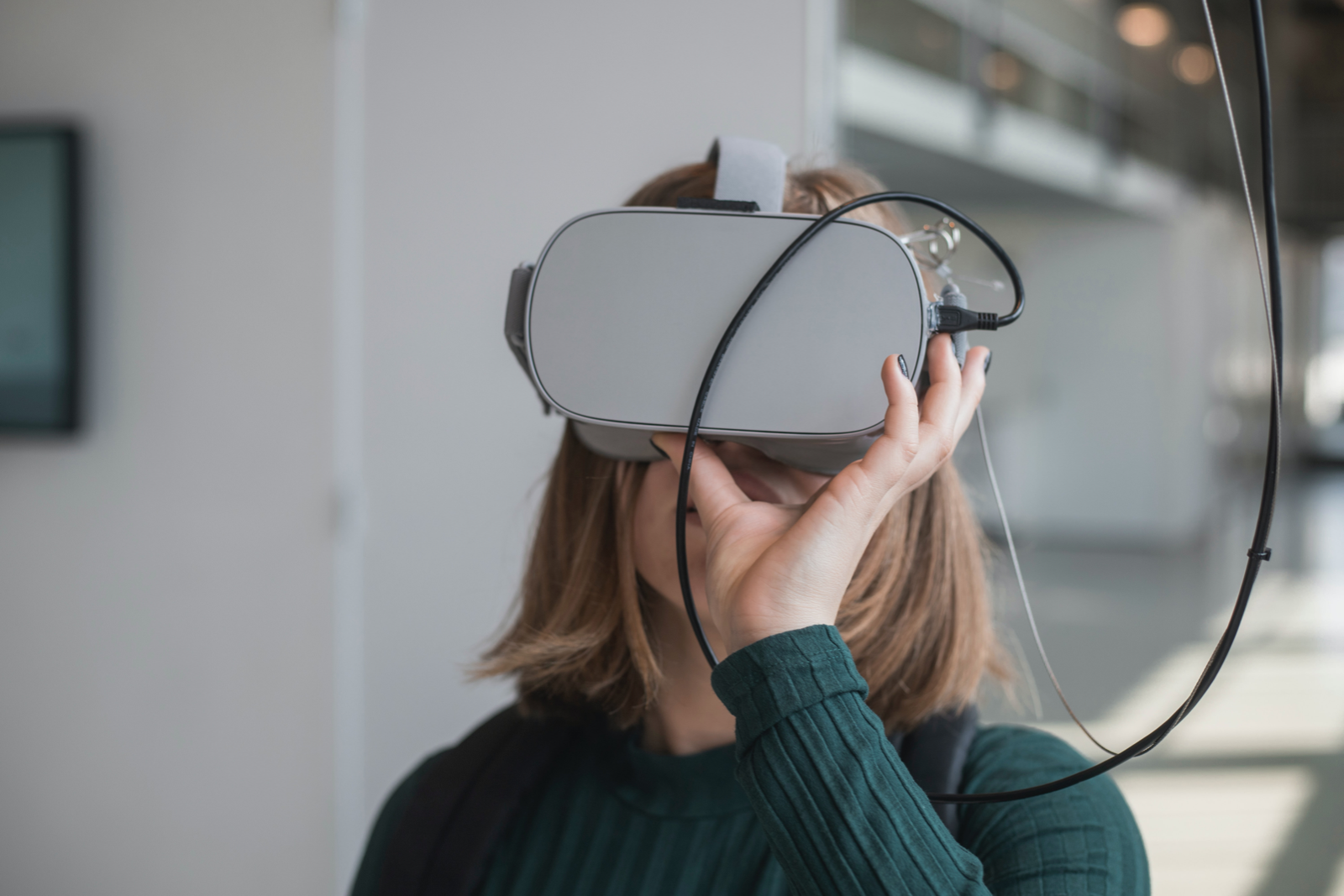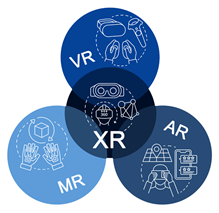XR Can Yield Extraordinary Results

Extended reality (XR) experiences first hit the mainstream as an innovation of video game technology. Now marketers are leveraging XR’s potential—including augmented reality (AR) and virtual reality (VR)—to increase consumer engagement with their brands. Immersive XR campaigns help bring brand experiences close to real life experiences from practically anywhere. Plus, with virtual conferencing like Zoom and Teams now commonplace for social and work interactions, consumer expectations have taken a sharp digital turn. No wonder brands are beginning to create XR experiences that appeal to consumers’ practical, adventurous, and even artistic sides.
Extended reality encompasses various technology capabilities, including:

-
Augmented reality (AR): technology that superimposes a computer-generated image on a user’s view of the real world for a composite view
-
Virtual reality (VR): a computer-generated simulation of a three-dimensional image or environment that a user interacts with in seemingly real or physical ways using special equipment, such as a helmet with a screen inside or gloves fitted with sensors
-
Mixed reality (MR): a combination of AR and VR elements to create a blended view of digital objects and the real world
Each technology creates an immersive experience. While none are brand new, all have undergone accelerated, and noteworthy, applications into digital campaigns during the pandemic. Here we examine successful marketing uses of XR and offer recommendations for how this emerging strategy can be best utilized by brands.
XR already has traction with consumers
While AR and VR may be far from common brand marketing tactics, these applications are already status quo for recreational online use with gaming, social media, and more. In fact, eMarketer estimated that 165 million people in the U.S. would use some form of XR at least once per month in 2022. That number represents more than 40% of the population, and it’s a significant leap from the one-million-per-month usage rate in 2020. This increase illustrates consumers’ desire for more and new ways to interact digitally when their capacity to interact in person was limited during the pandemic.
Some brands were quick to jump on this XR trend as a way to build consumer digital engagement. Brands that adopted XR-related campaigns early on are reporting significant benefits to their core metrics. And Zappar, a leading AR platform creator, reports that the creative application of AR for customer engagement increases brand awareness by nearly 70%.
Brands using XR marketing anticipate impressive results
Brands driven by e-commerce are realizing a great return by introducing XR to enhance online shopping experiences. Retail Customer Experience reports that early-adopting brands of XR shopping experiences are seeing an increase in conversion rates by a whopping 90%. In particular, Houzz, an online home-goods retailer, says consumers engaging with their View in My Room 3D tool were 11 times more likely to make a purchase, and spent 2.7 times more than consumers who opted not to use the AR application. If those stats aren’t compelling enough, Business Newswire shared a study that shows 61% of consumers said they prefer retailers with AR experiences.
Choosing the right XR approach for your brand
Today’s most effective and popular XR marketing campaigns all demonstrate clear intentions to educate, entertain, or engage their target customer audiences with experiences. Below are highlighted successful campaigns that fall into each of these categories and demonstrate how XR can significantly boost brand engagement and further cement customer loyalty.
Educate
Immersive learning experiences delivered via XR campaigns can effectively nurture customers along the buyer journey to loyalty. In addition, helping current and prospective customers to grow their experiences with a brand’s products is a great way to increase customer satisfaction. And training through hands-on simulations can heighten the learning experience.
The Gibson guitar app is an ideal example. This audio AR app creates an immersive experience for the learner, simulating a private instructor who provides real-time feedback. In fact, Gibson calls the combination of their app and YouTube channel the ultimate guitar teacher—and that superlative claim is backed by hundreds of five-star user reviews.
Another popular educational application is Lowe’s Holoroom How To, an in-store VR station. This innovative but simple tutorial enables novice home-improvement customers to learn by doing in a simulated session. According to Lowe’s, customers who use this VR tutorial, instead of just watching a video, have a 36% higher recall of the information shared.
Entertain
Sometimes the best way to stand out from the competition is to capture the imaginations of your customers through entertaining experiences. XR campaigns have limitless possibilities to entertain customers in new ways, and several brands recently showcased this potential to engage millions.
Pizza Hut took their humble pizza box and creatively turned it into XR entertainment as the backdrop for an AR-driven game of Pac-Man. The #PizzaHutARcade game was an instant hit, inviting customers to have fun with their packaging before even enjoying their dinner. Pizza Hut also tapped into nostalgia for millions of Pac-Man enthusiasts who could relive their favorite arcade memories.
Adidas knows climbing enthusiasts are always seeking new challenges. So, in an XR campaign to entertain and engage their climbing community of Terrex apparel wearers, Adidas launched a VR simulation of a route up the Delicatessen, a notoriously difficult climb in Corsica taken by famed freestyle climbers Delaney Miller and Ben Rueck. With its Virtual Climb app, Adidas grants customers the thrill of reaching the summit—from the safety of their own environments.
Experience
We’ve all felt that moment of hesitancy right before making a purchase: Is this product the right one for my needs? To help overcome any resistance, brands are turning to XR to help shoppers simulate the experience of owning or using the product. Essentially, these campaigns let customers virtually test-drive a product before purchasing.
Take, for example, the Sephora Virtual Artist app. An image of a user’s face is displayed with a split screen. The left side maintains the original image, while the right side enables virtual makeup application to create a before-and-after effect. Color and shading combinations are instant and limitless.
Meanwhile, The Home Depot’s innovative 3D AR tool allows online shoppers to see how products look in their own homes before purchasing. Not only does this increase customers’ confidence in their purchase decisions, but it reduces the inconvenience of getting a piece of furniture home only to then realize it doesn’t fit and must be returned.
Do it right the first time
XR campaigns—when done right—can have a major impact for a brand. Technology unlocks the opportunity, but the key driver of success for any XR campaign is alignment of brand value propositions and customer needs.
Given the extensive resources required to conceive, build, and deploy XR campaigns, it’s critical to ensure your campaign serves a clear purpose to enhance your customer experiences in ways traditional formats can’t fulfill. Once you’ve identified the right approach, a clear audience, and primary needs, it’s time to breathe virtual life into your brand’s XR campaign.
Reimagine your engagement results
Not only can XR campaigns modernize your brand to help reach new and younger audiences, but they may attract customers who are fatigued by traditional shopping experiences. Whether your campaign aims to educate, entertain, or engage, XR provides a valuable nurturing tool along the consumer journey. And, who knows, with the coming metaverse, perhaps XR campaigns will soon become the primary marketing tactic to drive unimaginable campaign results.
Todd Hedberg is senior director of digital strategy at The Lacek Group, a Minneapolis-based, data-driven loyalty, experience and customer engagement agency that has been delivering personalization for its world-class clients for more than 30 years. The Lacek Group is an Ogilvy company.

